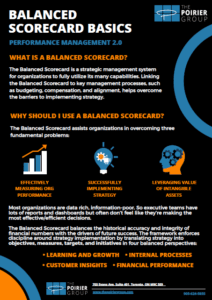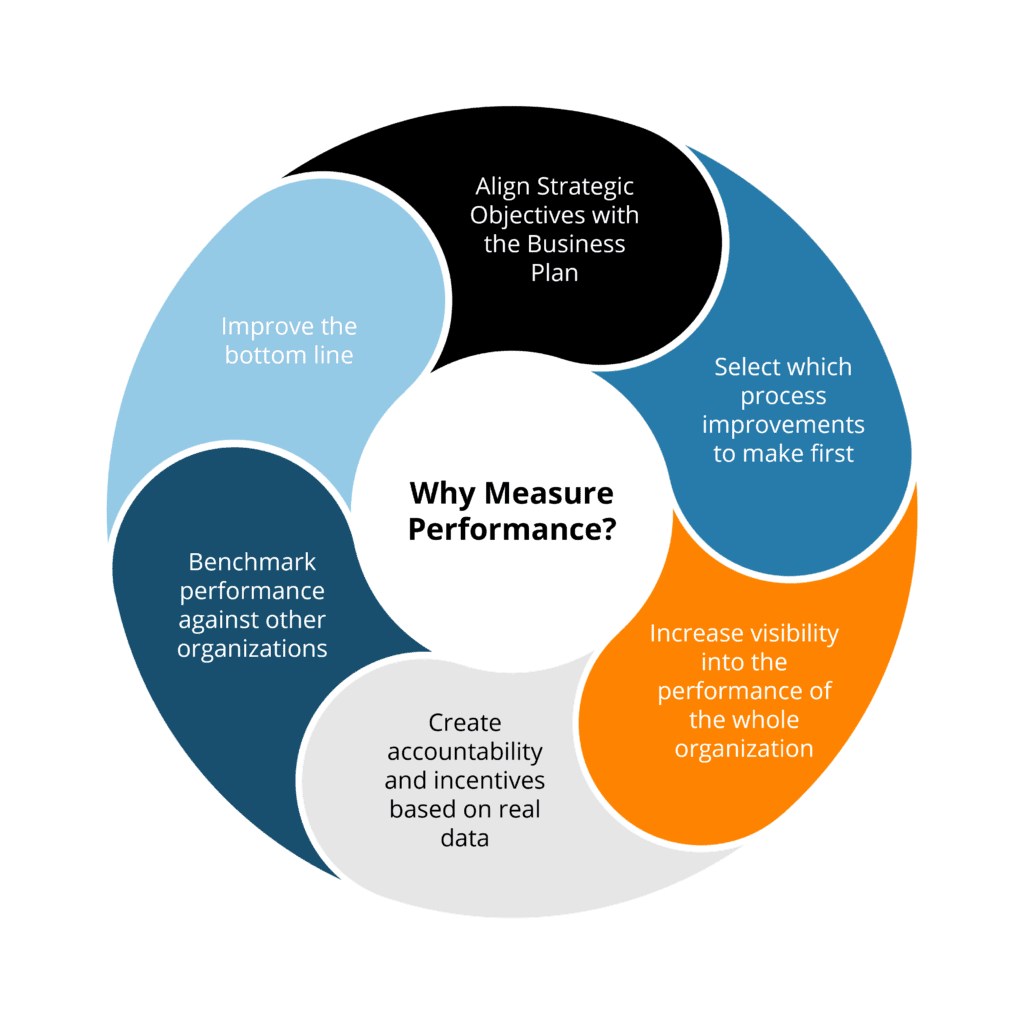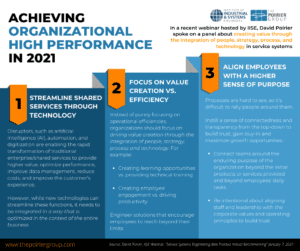
Performance management is the heart of your business strategy. It’s the means by which you measure, direct and control the efforts of your organization and its people to accomplish specific objectives.
Your business strategy is just words on a page unless you have the organization and people to deliver it. It must go hand-in-hand with a people strategy—one that tackles the pain points of today while at the same time addressing the obstacles in the way of your future.
The Poirier Group (TPG) helps you create a performance-driven culture focused on continuous improvement and leveraging technology and people skills. We help you develop an organization focused on customers, extending to employees, vendors and communities; one that continues to involve, develop and recognize your employees who contribute to your success; one that makes every day a little better than yesterday.
Performance management is your company’s ability to align performance and reward. It starts with understanding why your business strategy is important, and how it ties into the organization’s overall performance and aligns with how you want your employees to behave.
At TPG, we have developed a performance management system that focuses on the key drivers of your business strategy. This system tracks business and employee performance and measures the health of our culture at every level. It provides the basis for communicating goals, recognizing results, aligning action plans and rewarding excellence.
We help you identify your organization’s strengths and weaknesses, then develop a plan to leverage its assets and build on them.


Creating an organizational structure that aligns with your strategic priorities is the first step toward building a high-performing culture and securing long-term success. As a best-in-class provider of strategic consulting and performance management services, we work with you to clarify your organization’s business strategy and translate it into an operating model, structure, and processes—all with your people and culture in mind.
Our unique focus on culture and the human element of the strategy is essential to achieving future success. Using a comprehensive approach that includes executive facilitation, design thinking workshops, stakeholder interviews and simulations (e.g. scenario planning), we work with you to translate your company’s business strategy into reality.


As business owners, you have expertise in your field. But you can’t be experts on everything. That’s why we focus on helping you identify the most critical areas for your business where staff training and leadership development can have the greatest impact. Our integrated approach creates a sustainable, scalable model for you to follow long-term. It will enable you to attract top talent, retain high performers and help drive your business into the future—one that’s aligned with your values, mission and goals.
Our approach to performance management is to use objective measurement data at the strategic level, with dashboards and reports designed to provide key facts on your business performance. This is then used to support the larger goals of your organization’s strategy. We use metrics and reporting to help you benchmark against other organizations in your industry or sub-sector.
The Poirier Group has experience in designing and implementing performance measurement tools in multiple industries. These tools will better connect the dots between big picture strategy elements, strategic focus areas, and the more operational elements such as objectives, strategic performance measures, targets and initiatives.
A collaborative approach to goal setting, creating focus, alignment, accountability and acceleration of stretch goals.
Keep track of how employees are executing against activities and align tactical activities to the strategic plan.
Track the operation of your organization and indicate progress toward key metrics and strategic goals.
Streamline communication and decision-making while reducing hand-offs and rework between functional groups.
Keep the team aligned and heading in the right direction. Keep key personnel informed by creating transparency across departmental milestones.
Create a focused path, and motivate people towards accomplishing a goal together.
Performance management is focused on achieving a balanced framework that addresses poor management, learning and change; long-term goals over short-term goals; and asset creation and growth. The Poirier Group’s (TPG) strategic planning team offers a full range of services for designing and implementing balanced scorecard and KPI systems and other performance management tools. We then work with you to prepare recommendations for performance management improvement and leadership training.
The Poirier Group’s performance measurement solutions improve the management and delivery of products and services while improving the overall productivity and performance of your team. Manually managing information can result in outdated information being drawn from multiple systems and reports, resulting in a duplication of effort and inaccurate reporting. This can create difficulties in forecasting and creating strategic plans.
Performance Management tools help drive productivity and achieve high performance by enabling your company to measure and manage what matters, correct behaviour accordingly, and create accountability to deliver excellent products and services to customers. Let The Poirier Group help get your team back on track.
A Balanced Scorecard (BSC) is a strategy performance management system that allows managers to keep track of how employees are executing activities and allows an agency to align its strategic activities to the strategic plan. It guides your organization to set, track and achieve your strategic vision by ensuring you are not only doing things right, but are doing the right things right.
TPG works with organizations to build out custom balanced scorecards and trains internal teams on how to manage and maintain this tool. It creates readily available information, allowing decisions to be made strategically and quickly, and aligns business metrics with the vision and values; customer needs and wants; and employee objectives and performance.
Purpose:
Almost always customized, a Balance Scorecard (BSC) should build your objectives to measure yourself against key pillars of your organization (i.e. financial, customers, organizational capacity and internal processes), and track KPIs against your goals.
Major change often takes a long time, especially in big organizations. The Balanced Scorecard is never really complete because your business is never complete. Fortunately, the BSC is a flexible tool that can handle changing conditions as long as it is maintained, nurtured and built upon
Objectives and Key Results (OKR’s) is a collaborative goal-setting protocol for companies, teams and individuals.
Objective: What is to be achieved, which is aspirational, challenging, concrete and action oriented
Key Results: How we get to the objectives, which is Succinct, specific and measurable OKR’s are used for setting and tracking objectives to enable clarity and help ensure that the company focuses efforts on what truly matters. They are ultimately a collaborative approach to goal setting, creating focus, alignment, accountability and acceleration. OKR’s link diverse operations, lending purpose and unity to the entire organization. What makes them truly unique is that they are used by everyone at every level of the organization – from shop floor workers to C-Suite executives and can be either tactical or high-level. OKRs are also more aggressive and ambitious than traditional goal setting methodologies.
4 factors of OKRs:
With our clients, we distribute a weekly report card to facilitate integrity, accountability and transparency.
OKR and KPI work perfectly together. KPIs help monitor performance and identify problems and areas for improvement; OKRs help solve problems, improve processes, and drive innovation. You’ll need both.
Key Performance Indicators, also known as KPIs, are measures used to track the operation of your organization and indicate progress toward your strategic goals. While you may track many things relating to your business, it is important o identify a subset that are “key” to your overall success. This can be for an individual project or the overall success of your company. A strong KPI contains meaningful information that helps shape the decisions you need to make such as the revenue of a product line or the uptime of a key service. KPIs should be operational, strategic and achievement of them should lead to the success and sustainability of the business in the long term. Together, we establish key targets for managers of departments, branches, offices, business units and subsidiaries to work towards.
A good metric for a KPI meets 3 conditions:
TPG uses multiple tools and methodologies to create alignment between roles and responsibilities in an organization. This streamlines communication and decision-making while reducing hand-offs and rework between functional groups.
A RACI chart is one tool used to identify who is Responsible, Accountable, Consulted or Informed at each step in a process. Conducting a RACI on the current state process has many benefits including:
Setting you up for success, enforcing ongoing discussions and review of progress. This tool outlines all meetings, high level milestones, Standard Operating Procedures (SOP’s) for those meetings, key attendees across all departments and has a calendar view.
A Master calendar can help to:
Goal setting, alignment and management should be a priority for companies of all sizes and industries in order to prevent employees from getting overextended, keep everyone on a focused path, and to motivate people towards accomplishing a goal together. Goal alignment lets you capitalize on your employees’ performance and progress, which in turn drives profits.
The purpose of goal setting is to help the organization achieve high performance:


Aligning on roles and responsibilities is important especially in a complex matrix organization where there are lots of people working on a lot of different things, in different departments. As organizations grow, teams start to migrate into their own silos and what used to work in a small team sometimes doesn’t scale to a larger team.

Download PDF Download PDF

Performance Management tools help drive productivity and achieve high performance by enabling the company to measure and manage what matters, correct behaviour accordingly and create accountability to deliver excellent products and services to your customers.